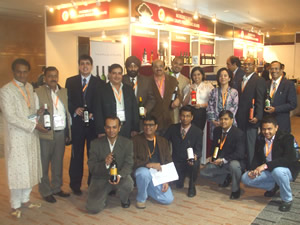Wines showcased by ten wineries at the recently concluded Hong Kong Wine Show in collaboration with the IGPB were a mixed bag in terms of quality ranging from poor to outstanding, writes Subhash Arora who tasted all the wines individually over two days.
 A big advantage at being a show or a festival where wines from the same country are being displayed is that one can taste and judge them on a common platform. I took the opportunity to spend a lot of time tasting all wines from India and rating them from 0-5 for my personal notes. A big advantage at being a show or a festival where wines from the same country are being displayed is that one can taste and judge them on a common platform. I took the opportunity to spend a lot of time tasting all wines from India and rating them from 0-5 for my personal notes.
I am listing the ones that scored 4 or more on my palate. There were a few which merited only 1 but the idea was to have a relative comparison and the higher numbers are not by international norms. Therefore, it won’t be fair for a producer to claim he scored 4 or 4.5 by being in this list.
Sparkling Wine
Omar Khayyam: The export version of the Marquise de Pompadour from Chateau Indage, this bubbly still rules the roost. Though it could not be ascertained if Indage uses Chardonnay, Pinot Noir and Ugni Blanc (Trebbiano) as they claim or a substantial amount of the eating variety Thomson Seedless finds its way into the bottle, but the wine is as crisp, fresh and lively as ever and compatible with a wide spectrum of Indian food.
Rosé
Blush from Sula: Though I feel sometimes that this wine is ‘tired’ now but at this tasting, it clearly came on top, for its fruitiness, soft tannins and a persistent taste on the mouth. The slight sweetness would make it an ideal combination with spicy Indian food
White Wine
Sauvignon Blanc 2009 Grover: This is the best vintage Grover has produced since it brought this varietal out about 4 years ago. It has also clearly established itself differently from the herbaceous style with green pepper and asparagus that one finds in Nashik version. The style here is distinctly fruity with tropical and floral notes. The crisp acidity coupled with an attractive nose and a persistent taste makes it an ideal wine to usher in a non wine drinker to the wonderful world of wine.
Dindori Reserve Viognier 2009 Sula: This relatively new varietal introduced by
Sula last year has really charged ahead and charmed palates with the spiciness and flavours that are enticing and dance on the palate all the way. With around 90% of the grape being Viognier, the results have come out more impressive than Grover who pioneered the blend with 60% Viognier, the balance being Clairette.
Red Wine
La Reserve 2007 Grover: The evergreen blend from Grover waivered for a while but is back with a bang. The well-oaked wine has ripe tannins and a persistent berry flavours with slightly peppered notes and a long end.
Platinum Series Merlot Shiraz 2007 Indage: Quite a surprise package-this one. Although I could sense a bit of Australia in the blend and at Rs. 800 + VAT it is more expensive, it is a very clean, spicy and flavourful wine with a fruity taste that persists on the mid and back palate. It should age further for a year or two.
Cabernet Sauvignon Reserve Reveilo: Yatin Patil of Vintage Wines has succeeded in achieving a special quality in his Reserve wines made from low-yielding grapes.\ and barrique aging and some help from Italy But it would have a niche market because of the high prices of around Rs.1200. The rich, powerful and big wine makes you want to have another glass and fine food matched with it, will taste better with a glass of this wine.
Dessert Wine
LH Chenin Blanc Sula: What really goes in favour of this wine is that the sugar sweetness are well-balanced with acidity which gets more important as the sugar level goes up. Whereas most of the Late Harvest wines tasted as if chaptalisation had been carried out, this one has concentrated flavours of honey and tropical fruits with enough acidity to balance.
Some of the other labels which almost made to the list were a yet-to-be-released Cab Reserve from the UB-owned Four Seasons, my favourite Dindori Reserve Shiraz Sula and a fruity Zinfandel from Big Banyan.
Comments
The tasting at a common platform brought out two important factors-one that the wine must be clean on the nose and the palate and the other that wine in the tanks is not necessarily ‘liquid gold.’ Some of the wines I had tasted on earlier occasions were slightly oxidised or had lost their freshness and were on a downward journey.
I hope all the producers also tasted the competitors’ wines, as they regularly should. It keeps thief mind sharp, objective and make them less mug, prejudiced or egotistic.
The award for the best wine would of course, go to IGPB who organised the India stand. Being the first one India to organise a similar stand for the first time-in
Singapore in 2005, I know the difficulties involved. But with the adequate funds in its glass, it must encourage and ensure the participation by the producers at the shows as also international wine competition for them to seriously work on improvements.
Many of the other active producers like Seagram’s Nine Hills, Zampa, Vinsura, Mercury, York and Miazma were absent and were not tasted.
Subhash Arora |